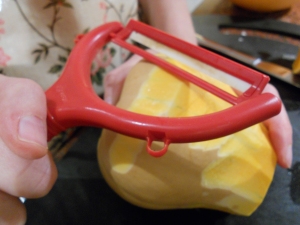I never considered myself much of a baker. But when I captained a phone bank in last year’s special election (don’t get me started), I thought the least I could do for my volunteers was to reward them with some good cookies. I came across this recipe and took a liking to it.
After mastering this simple recipe, I realized there was nothing stopping me from baking all sorts of things, from lemon bars to macarons to challah to apple cake. But today, I found myself wanting to bake these cookies again.
This is a pantry recipe. It involves butter, which should just live in your freezer, so you’ll always have it at hand. You should have eggs in the fridge, and everything else you’d have on hand in your pantry. Chocolate chips and dried fruit? In your pantry. Or, you might have to store chips in your freezer if your pantry gets too warm in the summer.
I actually had a bit of trouble with some of my batches of cookies today. The recipe wasn’t off. My oven was. So the cookies in the pics you have here are not my best work. But I promise you it makes a good cookie. If you’re into chewy with lots of good bits of stuff, this recipe is for you. Side note: I actually like the way these cookies taste the next day more than a few hours out of the oven.
The recipe I like to use is from The Fannie Farmer Cookbook, which has the same ingredients as Toll House, but in different measurements. They also differ on greasing the pans: Fanny is pro and Toll House is con.
The cookies in these pictures are a mixture of the newly invented Cherry Garcia, chocolate and peanut butter chips, chocolate chip and heath crunch. (I intentionally leave nuts out of my cookies when I don’t know who I’m baking for; it’s just safer that way. But if you know who you’re baking for, have fun with the nuts.)
The amount you want to pay attention to is 1 cup of chips to half a cup something else, say dried fruit or nuts. Make sure to chop up whatever that is, be it dried fruit, or nuts, or both. The Cherry Garcia cookies, for instance, were 1 cup of chips to half a cup chopped dried cherries — which Ocean State Job Lot always has on hand. The Heath Bar Chip? A cup of chips to a half cup Heath Bar bits; the Heath English Toffee Bits, “Bits O’ Brickle Toffee Bits” were actually a pantry addition by Rich and Mike.
Whatever “side” your on, if you want to help out on a campaign but feel weird about talking to strangers, you can pitch in by baking a batch of cookies for the volunteers.
Chocolate Chip Cookies
Adapted from The Fannie Farmer Cookbook
1/4 pound butter
1/2 dark brown sugar
1/2 cup granulated sugar
1 egg
3/4 teaspoon vanilla
1 cup and two tablespoons flour
1/2 teaspoon salt
1/2 teaspoon baking soda
1/2 cup chopped nuts or chopped dried fruit, or both
6 ounces semisweet chocolate chips (1 cup)
Preheat oven to 375 and grease some cookie sheets. Cream the butter, then gradually add the two sugars, beating until light and smooth. Beat in the egg and the vanilla. Mix the flour, salt and baking soda and add it to the first mixture blending well. Stir in the nuts/dried fruit and the chocolate chips. Drop by teaspoonfuls* onto the cookie sheets about 1 inch apart and bake for 8-10 minutes or until lightly browned.
Both recipes say you can make an average of 55 cookies with this recipe. It’s more like 2 dozen.
*I don’t usually complain about products, but feel I must in this case. Two weeks ago I had attempted to make cookies for the campaign, but my cookie scoop lost one of its rivets that held the sweeper in place. I couldn’t bring those to the campaign; what if someone bit on that rivet? I brought it back to Crate and Barrel, and they replaced it immediately. This is what happened during today’s baking.




















